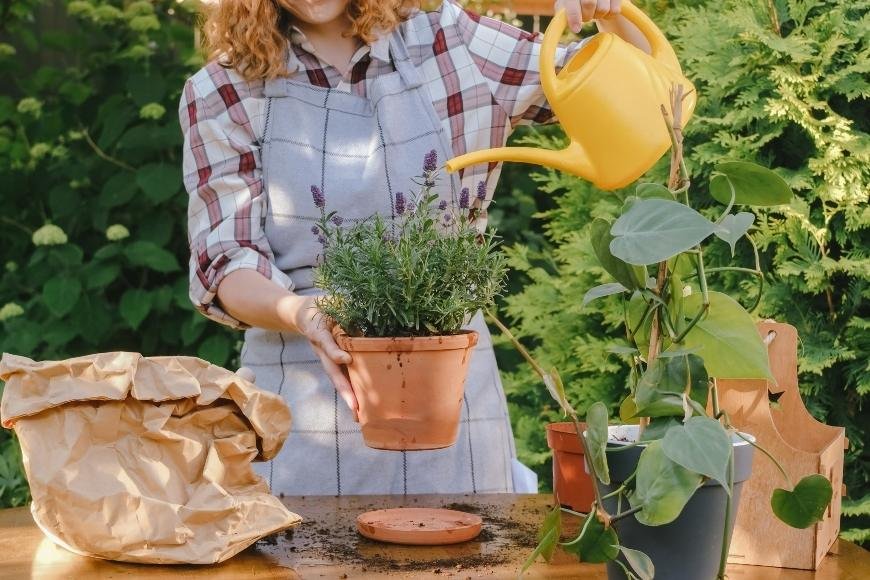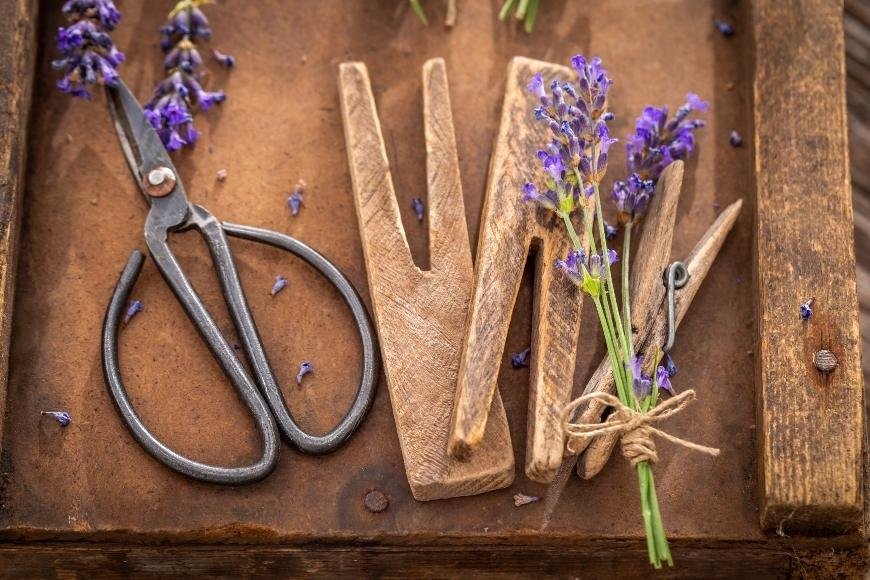How to Grow Lavender
Learn how to grow lavender with our comprehensive guide for beginners, covering planting, watering, pruning and more for a thriving home garden.

How to grow lavender is an art that can be mastered with a little patience and knowledge. This fragrant, versatile plant has been used for centuries in various applications, from essential oils to culinary delights. By following the instructions in this blog post, you can gain the necessary skills to successfully cultivate your own lavender plants and reap their many benefits.
In the sections below, we will explore important aspects of growing lavender such as choosing the right location for planting, preparing well-drained soil, selecting appropriate varieties like English or French lavender, and ensuring proper care through watering and fertilizing techniques. Additionally, we will discuss pruning methods for maintaining healthy growth patterns while controlling pests and diseases that may threaten your thriving plants.
Lastly, harvesting your homegrown lavender flowers at the perfect time will provide you with an abundant supply of aromatic blooms suitable for numerous uses. So let's dive into our comprehensive guide on how to grow lavender!
Table of Contents:
- Choosing the Right Location
- Preparing the Soil
- Planting Lavender
- Watering and Fertilizing
- Pruning and Deadheading
- Controlling Pests and Diseases
- Harvesting Lavender
- Frequently Asked Questions How to Grow Lavender
- Conclusion
1. Choosing the Right Location
Young people who are keen to get into the hobby of cultivating plants can find great satisfaction and relaxation in growing lavender. To ensure your lavender plants thrive, it's essential to select an appropriate location that meets their specific needs.
Lavender requires plenty of sunlight, well-draining soil, and adequate air circulation. When scouting out potential spots for your lavender garden, consider these factors:
- Sunlight: Lavender thrives in full sun exposure; aim for at least six hours of direct sunlight per day.
- Soil type: Well-draining soil is crucial as lavender doesn't tolerate wet roots or standing water. Sandy or loamy soils with good drainage work best.
- Air circulation: Good airflow helps prevent fungal diseases and encourages healthy growth; avoid planting near walls or fences that may block air movement.
Countries/Regions Best Suited for Growing Lavender
Lavender grows best in regions with warm summers and mild winters such as Mediterranean countries like France, Italy, Spain, Greece and Portugal (USDA hardiness zones 5 through 9). However, some varieties can withstand colder climates if provided with proper care during winter months (e.g., mulching).
Tougher Regions to Grow Lavendar Successfully
Regions with high humidity, heavy rainfall or extreme cold temperatures can make it more challenging to grow lavender. In these areas, consider growing lavender in raised beds or containers for better drainage and protection from harsh weather conditions.
2. Preparing the Soil
Growing lavender requires a well-prepared soil to ensure healthy growth and abundant flowering. The ideal soil conditions for lavender are slightly alkaline, well-draining, and nutrient-rich. Here's how you can prepare your garden bed or container for planting:
A. Test Your Soil pH
To ensure your soil is suitable for lavender, use a soil testing kit to measure its pH level; the ideal range should be between 6.5 and 7.5, which is slightly alkaline. To determine your soil's pH level, use a soil testing kit available at most gardening stores or online retailers.
B. Amend the Soil if Necessary
If your soil test indicates an acidic pH level (below 6), you may need to increase it by adding agricultural lime or wood ash from untreated hardwoods, at a rate of approximately one cup per square yard.
- Lime: You can purchase agricultural lime from any gardening store and follow the package instructions on how much to apply based on your current soil pH levels.
- Wood Ash: If you have access to wood ash from burning untreated hardwoods, sprinkle approximately one cup per square yard over the area where you plan to plant lavender; then mix it into the top few inches of soil before planting.
C: Improve Drainage
Lavender plants require well-draining soils as they do not tolerate waterlogged conditions that may lead to root rot issues later on in their life cycle. To improve drainage in heavy clay soils:
- Add organic matter like compost or aged manure to the planting area.
- Consider incorporating sand, perlite, or small gravel into your soil mix to improve its structure and drainage capabilities.
- Create raised beds for better water management in areas with poor drainage conditions.
D: Add Nutrients
Lavender plants benefit from a nutrient-rich environment. To provide essential nutrients:
- Mix in well-rotted compost or aged manure into the top few inches of soil before planting lavender seedlings; this will not only add valuable nutrients but also help improve overall soil structure and fertility over time.
- Apply an all-purpose slow-release granular fertilizer at planting time according to package instructions for best results. This will ensure that your lavender plants receive a steady supply of nutrients throughout their growing season without risking over-fertilization issues commonly associated with liquid fertilizers applied too frequently during growth stages when they are most vulnerable to damage caused by excess nitrogen levels within their root systems.
Once you have prepared the soil, your lavender plants will be ready to thrive. Now that the basic steps have been taken, it's time to start planting lavender.
3. Planting Lavender

Growing lavender is an exciting and rewarding experience, especially when you see those beautiful purple flowers blooming in your garden. To ensure a successful planting process, follow these simple steps:
Selecting the Right Variety
First, it's important to choose the right variety of lavender for your specific needs and location. There are several types of lavender available, each with its own unique properties and growth habits. Some popular varieties include Lavandula angustifolia, also known as English Lavender; Lavandula x intermedia, or Lavandin; and Lavandula stoechas, commonly referred to as Spanish Lavender.
Planting Time & Depth Requirements
The optimal period to sow lavender is when temperatures are moderate, neither too cold nor excessively hot, usually in spring or early autumn. This will give your plants ample time to establish their roots before winter arrives.
- Spacing: Space your plants approximately 18-24 inches (45-60 cm) apart from one another in rows that are at least 30 inches (75 cm) wide.
- Depth: Dig holes deep enough so that the top of the root ball sits just below ground level - usually around 4-6 inches (10-15 cm).
Tips for Successful Planting
- Soil: Make sure your soil is well-draining and has a pH level between 6.0 and 8.0, which is ideal for lavender growth.
- Mulch: Add a layer of gravel or small stones around the base of each plant to help with drainage and prevent excess moisture from causing root rot.
- Sunlight: Ensure that your plants receive at least six hours of direct sunlight per day - this will promote healthy growth and abundant flowering.
Incorporating these planting tips into your gardening routine will set you on the path to successfully growing beautiful, fragrant lavender plants in no time.
4. Watering and Fertilizing
Growing healthy lavender plants requires a proper balance of watering and fertilizing to ensure they thrive in your garden or container. Lavender is known for its drought tolerance, but it still needs some attention when it comes to hydration and nutrition.
Watering Your Lavender Plants
Lavender favors soil with good drainage, so take care not to give it too much water as this can result in root decay. During the first year after planting, water your lavender once or twice a week depending on the climate you live in. In hotter climates, more frequent watering may be necessary while cooler regions might require less.
Once established (after one year), reduce watering frequency to every two weeks during dry periods or hot summers; otherwise, let rainfall take care of their hydration needs. Keep an eye on your plant's leaves - if they start wilting despite regular watering schedule adjustments based on weather conditions such as humidity levels and temperature fluctuations.
Fertilizing Your Lavender Plants
Lavenders are not heavy feeders; however, providing them with essential nutrients will promote healthier growth and more vibrant blooms. Use a slow-release granular fertilizer specifically formulated for flowering plants at the beginning of spring before new growth starts appearing.
- Nitrogen: A balanced amount of nitrogen promotes leafy green foliage without causing excessive growth that could weaken the plant structure.
- Phosphorus: Phosphorus aids in strong root development and enhances flower production.
- Potassium: Potassium helps improve overall plant health and resistance to diseases, pests, and environmental stressors such as drought or cold temperatures.
Avoid using high-nitrogen fertilizers as they can lead to excessive foliage growth at the expense of flower production. If you're growing lavender in containers, consider using a liquid fertilizer diluted to half strength every four weeks during the growing season for optimal results.
Maintaining a proper balance between watering and fertilizing your lavender plants will ensure their healthy growth and abundant flowering. Remember that moderation is key - too much water or fertilizer can harm your plants just as easily as not providing enough.
5. Pruning and Deadheading
Growing lavender is not just about planting and watering; it's also essential to keep your plants in good shape by pruning and deadheading them regularly. This will promote healthy growth, increase flower production, and maintain the overall appearance of your lavender plants.
When to Prune Lavender
Prune your lavender plants in the spring or early summer when new growth begins to ensure healthy growth, increased flower production, and overall appearance. It's crucial not to prune too early in the season, as this can lead to frost damage on tender new shoots. To ensure optimal plant health, make sure you prune at least once a year.
How to Prune Lavender Plants
- Remove dead wood: Start by removing any dead or damaged branches from the base of the plant using sharp pruning shears.
- Cut back old growth: Next, trim back approximately one-third of last year's growth on each branch while maintaining an attractive rounded shape for your plant.
- Tidy up foliage: Remove any remaining spent flowers (deadhead) and tidy up any straggly leaves around the base of the plant.
Note that different varieties of lavender may require slightly different pruning techniques; always research specific requirements for your chosen variety before starting.
Maintaining Your Lavender Plant Throughout The Season
In addition to annual pruning sessions, it's essential to perform regular maintenance tasks throughout the growing season. These include:
- Deadheading: Regularly remove spent flowers to encourage continuous blooming. This will not only keep your plants looking fresh but also help prevent seed formation, which can reduce the plant's overall vigor.
- Weeding: Keep the area around your lavender plants free of weeds, as they compete for nutrients and water in the soil.
- Mulching: Apply a thin layer of organic mulch (such as straw or bark chips) around the base of your plants to help retain moisture and suppress weed growth. Be sure not to pile mulch against the stems, as this can cause rotting issues.
Maintaining your lavender plants with regular pruning and tending is essential for them to stay in good condition and thrive. By following these simple steps, you'll be rewarded with beautiful blooms that add color, fragrance, and even medicinal properties to your garden or home projects.
Pruning and deadheading are essential for the health of your lavender plants. Proper pruning will ensure healthy growth and abundant blooms. To ensure that your lavender stays in optimal condition, it's important to take steps to combat any potential pests or illnesses.
6. Controlling Pests and Diseases
Lavender plants usually boast robustness and immunity to many pests and illnesses, but there are still some issues that may arise. In this section, we'll discuss some common problems that may arise while growing lavender and provide tips on how to prevent or treat them.
Aphids
Aphids are small insects that suck the sap from plant leaves, causing damage and potentially spreading disease. To keep these pesky bugs at bay:
- Inspect your lavender plants regularly for signs of aphid infestations.
- If you spot a few aphids, try removing them manually with a cloth or spray of water.
- In case of severe infestations, consider using organic insecticides like neem oil or insecticidal soap.
Powdery Mildew
Powdery mildew is a fungal disease that appears as white powdery spots on leaves. It thrives in humid conditions and can spread quickly if not addressed promptly. Here's what you can do to prevent it:
- Maintain proper spacing between your lavender plants to ensure good air circulation.
- Avoid overhead watering; instead, water at the base of the plant early in the day so foliage dries before nightfall.
- If powdery mildew does appear on your lavender plants, apply an organic fungicide like sulfur or potassium bicarbonate.
Root Rot
Root rot is a fungal disease that affects the roots of plants, causing them to decay and eventually die. Lavender plants are particularly susceptible to root rot if they're overwatered or grown in poorly-draining soil. To prevent this issue:
- Ensure your lavender plants are planted in well-draining soil and avoid overwatering.
- If you suspect root rot, remove affected plants from the garden immediately to prevent it from spreading to healthy plants.
- Treat remaining healthy lavender with a biological fungicide containing beneficial microbes such as Trichoderma spp., which can help suppress harmful fungi in the soil.
By staying vigilant and taking preventive measures against pests and diseases, you'll be able to enjoy beautiful, fragrant lavender all season long.
Controlling insect infestations and plant ailments is essential for a successful lavender cultivation, so it's critical to be familiar with the most effective methods. Next up, we'll look at the process of harvesting your lavender crop.
7. Harvesting Lavender

Growing lavender is a rewarding experience, especially when it comes to harvesting those fragrant flowers. The optimal moment for gathering lavender depends on what you intend to do with it. If you're looking for dried buds or using them in crafts and cooking projects, timing is essential.
When to Harvest Lavender
The ideal time to harvest lavender is when about 50% of the flower buds have opened up on each stem. Typically, this happens during the middle of summer; however, it is essential to monitor your plants as the precise timing can fluctuate depending on variables such as climate and type. By harvesting at this stage, you'll get the maximum fragrance from your blooms while still retaining their beautiful appearance.
How to Harvest Lavender
- Select healthy stems: Choose stems with mostly open buds and no signs of wilting or disease.
- Cut close to the base: Using sharp pruning shears or scissors, cut each stem close its base without damaging any new growth beneath it (source). Cutting lower down will also encourage bushier growth in future seasons.
- Gather into bundles: Collect several stems together (around 10-15) and secure them with a rubber band or twine near their bases.
Drying Your Lavender Harvest
To properly dry harvested lavender flowers for storage or use in various projects follow these steps:
- Hang upside down: Hang the bundled lavender stems upside down in a dark, dry, and well-ventilated area. This will help preserve their color and fragrance.
- Allow to dry: Leave your lavender hanging for about 2-3 weeks or until they are completely dried out. Check on them periodically to ensure there is no mold growth or other issues.
- Store properly: Once dried, store your lavender buds in an airtight container away from direct sunlight. They can be used for various crafts, cooking projects, or even as natural air fresheners around your home.
Growing and harvesting lavender is not only enjoyable but also offers numerous benefits such as adding a touch of beauty to your garden while providing you with fragrant flowers that can be used in various ways. With proper care and attention during the growing process, you'll have an abundant harvest ready for use throughout the year.
Frequently Asked Questions How to Grow Lavender
What is the best way to grow lavender?
The best way to grow lavender is by choosing a sunny location with well-draining soil, planting it in early spring or fall, watering sparingly, and fertilizing occasionally. Regular pruning and deadheading promote healthy growth while controlling pests and diseases ensure plant health. Harvesting at peak bloom maximizes fragrance and potency.
How do you take care of a lavender plant?
To care for a lavender plant, provide ample sunlight (6-8 hours daily), maintain well-drained soil with neutral pH levels (6.7-7.2), water moderately but consistently during dry periods, fertilize lightly using organic matter or slow-release fertilizer once per year, prune annually after flowering season ends to encourage new growth.
How easily does lavender grow?
Lavender grows relatively easily when provided with proper growing conditions such as full sun exposure, well-draining soil with neutral pH levels (6.7-7.2), adequate spacing between plants for air circulation (18-24 inches apart) and appropriate climate zones ranging from 5 through 9.
Where is the best place to plant lavender?
The ideal spot for planting lavender includes locations that receive at least 6-8 hours of direct sunlight daily along with well-draining soil having neutral pH levels (6.7-7.2). Elevated areas like slopes or raised beds are preferable as they help prevent root rot caused by excess moisture accumulation around roots.
Conclusion
With the right location, soil preparation, planting techniques, watering and fertilizing schedule, pruning methods, pest control strategies and harvesting plan in place you will be able to successfully grow lavender for years of enjoyment. Be sure to take all these steps into account when planning how best to grow lavender so that you can reap its many benefits.


































































































































